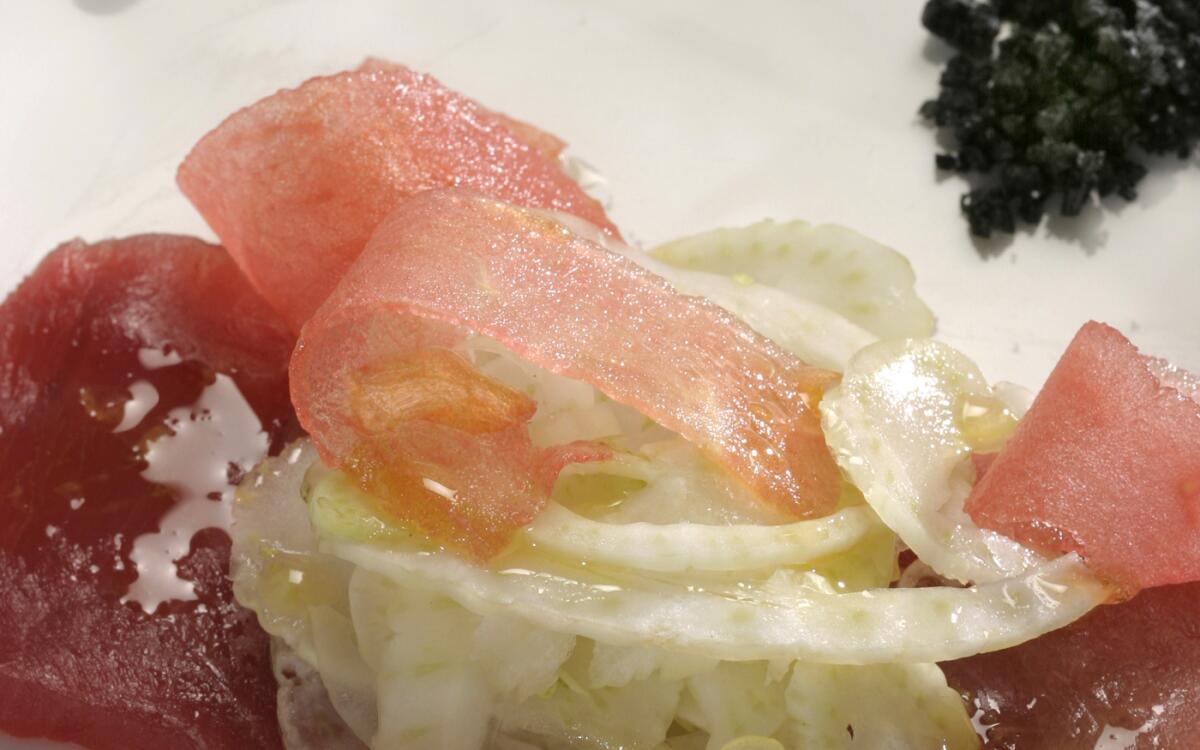Tuna carpaccio with shaved fennel and watermelon

There’s nothing more alluring than a nice, close shave.
And it doesn’t apply only to a man’s face: Vegetables and fruits could use a shave, too. No, they don’t get a 5 o’clock shadow. And no, you don’t shave them with a Gillette. You use a mandoline. Or a good vegetable peeler. Or sometimes a very sharp knife.
The transformative power of the simple technique of very thin slicing is nothing short of stunning.
Anyone lucky enough to have been in possession of a truffle, black or white, knows the pleasure of that particular shave -- and how slicing it so thin changes it from a fungus you’d never want to bite into one of the most amazing things you can eat.
But for a much less recherche example, take the prickly artichoke. You’d never think of eating one raw. Eating even a baby artichoke would be akin to eating wood -- with a garnish of prickles. But shave baby artichokes and the texture changes radically: The slices, in their wonderful thinness, are tender. Somehow even the flavor changes -- air becomes an ingredient and the raw thistle is suddenly delicate rather than impenetrable.
That’s the idea of the artichoke salad at La Botte in Santa Monica, where chef Stefano De Lorenzo shaves baby artichokes into lengthwise slices. When he tosses them with a mustardy lemon-olive oil dressing, they really soak it up.
But De Lorenzo doesn’t stop shaving there -- he’s a regular Figaro, adding shaved celery heart and shaved Parmigiano-Reggiano. He tosses all that with arugula and more dressing, to marvelous effect. Somehow, because the ingredients are all tissue-thin, the flavors combine in a way that they wouldn’t otherwise.
Asparagus aspirations
At Zuni Cafe in San Francisco, chef Judy Rodgers has been known to shave raw white asparagus, for a salad with sliced blood oranges and shaved bottarga (salted, pressed dried tuna or mullet roe). She uses a vegetable peeler to shave thin slices off the peeled asparagus, making lovely white ribbons that get draped over the blood oranges. A microplane grater is used to shave the bottarga (tuna is her preferred roe with this salad).
That dish raises the question: Why not shave green asparagus? In fact, that makes a compelling salad too. Trim the bottoms of the spears, then peel them. Lay one flat on a cutting board and start shaving -- which in this case means more peeling. Toss the pale green ribbons with some julienned prosciutto or ventresca (Spanish tuna belly canned in olive oil; other high-quality canned tuna works well too) and a little vinaigrette, and it’s pretty fabulous.
Carrots done this way are brilliant: Use a peeler to shave pared red, yellow and orange carrots from the farmers market. Shave a baby beet or two the same way, if you dare, and toss it with the carrots, some chopped carrot greens and a light vinaigrette for a fresh take on carrot salad.
Shaving completely changes the nature of fennel. Cut it thick and you get plenty of crunch and a strong, sweet anise-like flavor that some people find overpowering. Shave it on a mandoline and the flavor goes much more subtle, making it a more cooperative partner for smoked salmon (dress the fennel with a mustardy vinaigrette to make a nice bridge). Or even yellowfin tuna carpaccio and shaved watermelon: That’s how Dakota Weiss, the new chef at Jer-ne at the Ritz-Carlton Marina del Rey, serves it.
The shaved fennel, she says, isn’t sweet, and “the shaved watermelon adds a note of sweetness.” Unlikely as it sounds, drizzled with a lemon zest-infused olive oil, it’s quite appealing, with a wonderful contrast of textures between the silky tuna, the barely crisp fennel, the juicy-fresh watermelon and crunchy crystals of black sea salt.
You can even shave ripe cantaloupe, giving a textural spin to the old classic prosciutto and melon. Let the ribbons fall on a plate, add a squeeze of lime, a drizzle of ruby Port and some unexpected chopped mint, then scatter jullienned prosciutto on top.
And why stop there? Certain big, red radishes could probably use a shave; ditto daikon. And don’t forget jicama -- which, sliced thin on a mandoline, benefits from a jaunty lime aftershave. Powder its nose with cayenne or chili powder, and you’re good to face the day.
To make the lemon oil, combine the lemon zest and the olive oil. Set aside.
Thinly slice the tuna (about one-fourth-inch thick), and piece it together into a (5-inch-by-2-inch) rectangle on each of four plates. Drizzle each with about one-half teaspoon lemon oil.
Shave the fennel across the grain on a mandoline. Divide into four portions (one-fourth cup each) and place on top of the tuna on each plate.
Using a long, sharp knife, cut the watermelon into 16 very thinly sliced 3-inch-long strips. Lay 4 slices over the fennel on each plate.
Season with a little sea salt and a drizzle of lemon oil. Garnish the plate with a small pile of black sea salt. Reserve the remaining lemon oil for another use.
Get our Cooking newsletter.
Your roundup of inspiring recipes and kitchen tricks.
You may occasionally receive promotional content from the Los Angeles Times.















